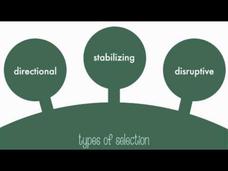Teacher's Pet
Evidence for Evolution
Just over 1/3 of Americans reject evolution, insisting all living things have existed in their present form for all of time. The video offers multiple types of support for evolution. It discusses the evidence from fossils, anatomy,...
Teacher's Pet
Speciation
Darwin believed species came from other pre-existing species. Now we know it is more complicated than that. The video focuses on speciation and patterns of evolution.
Teacher's Pet
Types of Natural Selection
Natural selection—good things come to those who mate. The video introduces the idea of natural selection. Then it details three types: directional, stabilizing, and disruptive. It includes both graphs and examples for each type.
Teacher's Pet
Disruption of Genetic Equilibrium
Could a population stay the exact same over time with no change in allele frequencies? The video explains the Hardy-Weinberg equilibrium theorem and the assumptions it requires. It discusses mutation, migration, gene flow, genetic drift,...
Teacher's Pet
Allele Frequencies
One way scientists describe diversity in a population is through allele frequencies. The video explains how to perform these simple calculations. Then it presents the Hardy-Weinberg assumptions and the difference between acclimation and...
Teacher's Pet
Population Genetics
Population genetics deals with genetic differences within and between populations. The video explains why this is the lowest level of evolution. Then it discusses mutations, environmental factors, genetic recombination, and random gamete...
Teacher's Pet
Species Interactions
Every species competes for food. The video explains interspecific competition, intraspecific competition, and the competitive exclusion principle as a part of predator-prey relationships. It also covers resource partitioning and the...
Teacher's Pet
Population Dynamics
Some scientists believe the earth is already over its carrying capacity for humans. The video explains what a carrying capacity is and the limiting factors to consider. It also teaches how to calculate growth rate, interpreting growth...
Teacher's Pet
Energy Transfer in Trophic Levels
Learn more about food chains, the food web, and the concepts relating to them. It focuses on consumers, producers, decomposers, energy transfer, and energy loss across trophic levels.
Teacher's Pet
Introduction to Ecology
An educational video offers an overview of ecology and discusses the levels of organization from biosphere down to organisms. It also compares terms such as habitats versus niches, generalist versus specialist, and biotic versus abiotic.
Teacher's Pet
Pedigrees
Docturs use a pedigree analysis chart to predict genetic disorders inherited in a family. The video explains how to interpret pedigrees and how to determine dominant, recessive, and sex-linked traits.
Teacher's Pet
Non-Mendelian Genetics
Any pattern of inheritance that does not follow Mendel's laws uses non-Mendelian inheritance. The video explains this type of genetics with many guided practice problems. It covers incomplete dominance, codominance, and sex-linked traits.
Teacher's Pet
Monohybrid Cross
Heterozygoes appear just a-llele uneven. The video explains how to solve monohybrid crosses using Punnett squares. It offers many practice problems determining the allele and percentages.
Teacher's Pet
Gregor Mendel
What did Gregor Mendel say when he founded genetics? Woopea! The video introduces Gregor Mendel to viewers. It details his initial experiments with peas and his understanding of genetics.
Teacher's Pet
Mitosis and Meiosis
Use chromosomes in marketing because as you know, sex cells. The video explains both mitosis and meiosis. It focuses on both the similarities and the differences in the process of forming sperm, egg, and zygote.
Teacher's Pet
Leaf Structure Lab
Two guard cells protect every stoma on a leaf. The video explains the structures of leaves, including stomatas. It details how to identify the parts under a microscope.
Deep Look
Banana Slugs: Secret of the Slime
Banana slugs eat animal droppings and leaves, all while generating waste that acts as a fertilizer. The video explains the slug's role in the ecosystem. It highlights the benefits of the slime for slugs' movement, food source, and even...
Deep Look
Newt Sex: Buff Males! Writhing Females! Cannibalism!
Taricha torosa travel up to three miles in order to reproduce, an impressive feat for something only six inches long. The video explains their mating rituals, which many consider rough and forceful. With a little cannibalism after...
Deep Look
What Happens When You Put a Hummingbird in a Wind Tunnel?
Hummingbirds consume their weight in nectar every day. The video explains their unusual flying abilities. From holding their bodies perfectly still while flapping their wings in mid air in order to get the nectar to shaking off water...
Teacher's Pet
Formation of Gametes
The smallest cell in a human body is sperm while the largest cell in a human body is an egg. The video discusses the formation of gametes from a scientific perspective. It includes the process of spermatogenesis, oogenesis and concludes...
Teacher's Pet
Stages of Meiosis
During meiosis, one cell divides twice, forming four daughter cells. The video explains the stages of meiosis in great detail. It begins with interphase and DNA replication, meiosis I, meiosis II, and finally the four haploid cells.
Teacher's Pet
Mutations in DNA
A human genome accumulates approximately 64 mutations per generation. The video explains the four types of mutations in DNA and their importance—or lack of importance. It incorporates knowledge about protein synthesis and combines it...
Teacher's Pet
Protein Synthesis
Only about two percent of DNA codes for protein. The video walks through the process of protein synthesis. It breaks down both transcription and translation into multiple steps.
Teacher's Pet
Proteins and Enzymes
Life begins with enzymes and ends without enzymes. The video explains where to find proteins and enzymes. It details how they work and why they are crucial to life.























